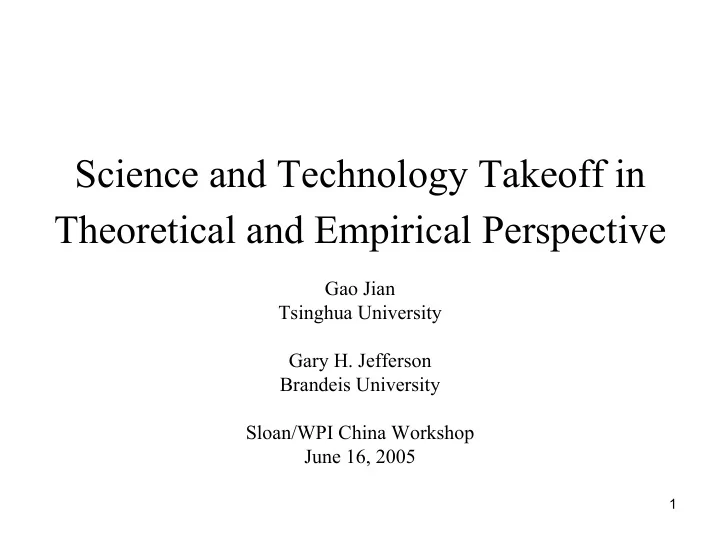

Science and Technology Takeoff in Theoretical and Empirical Perspective Gao Jian Tsinghua University Gary H. Jefferson Brandeis University Sloan/WPI China Workshop June 16, 2005 1
Science and Technology Takeoff: The example of China • Most large OECD nations experienced S&T takeoff in which R&D/GDP rose rapidly from < 1% to > 2%. • R&D/GDP has risen from 0.06% in 1996 to 1.3% in 2003. What can we learn from China’s experience about the conditions that drive S&T takeoff? • This is a measure only of R&D intensity, not quality 2
Scatterplot: R&D/GDP vs. log GDP/capita 3
S&T takeoff in 10 countries (vertical axis: R&D/GDP) 4
Changes in firm-level R&D intensity, 1995-2001 Distribution of R&D/VA (r), all L&M enterprises (%) 0<r ≤ 1 1<r ≤ 2 2<r ≤ 4 4<r ≤ 6 6<r ≤ 10 r>10 Year 0 1995 79.8 7.2 3.2 3.4 1.4 1.7 3.3 2001 70.9 6.7 4.0 4.8 3.0 3.5 7.1 % -11.1 increase (45.6) -7.5 22.8 40.8 108.0 110.8 119.1 5
A model of R&D intensity, Charles Jones, “ R&D-Based Models of Economic Growth, ” JPE (1995) Three sectors (R&D, intermediate inputs, final goods) → L R&D /L (i.e S) rises as: 1. The factor income share of production labor falls in relation to that of technology intensive intermediate inputs (i.e., ∂ S / ∂ α < 0) . 2. The productivity of R&D labor rises ( ∂ S / ∂ θ > 0) , 3. The elasticity of innovation w.r.t. the existing knowledge base grows ( ∂ S / ∂ φ > 0) , 4. Subsidies to R&D labor increase ( ∂ S / ∂ λ > 0) . 6
#1. An increase in the share of GDP dedicated to technology-intensive intermediate goods R&D/VA R&D/VA R&D/VA Sales Industry 1995 (%) 2000 (%) 2000/1995 share 2000/1995 Elec. and telecom equip. 2.97 7.34 2.49 1.91 Elec. equip. and machinery 1.71 4.98 2.91 1.15 Instruments and meters 2.86 4.65 1.63 1.28 Total industry 1.52 1.98 1.29 1.00 7
#2. Rise in productivity of R&D personnel Estimation equation to test for complements to R&D labor: lnV i = α 0 + α 1 lnK i + α 2 lnL i + α 3 lnR i + α 4 (lnR i *lnZ i ) + Σ j β ji LOC i + Σ k β ki IND i + ε i . V = value added, K and L are the net value of fixed assets and total labor, R = R&D personnel, Z is a vector of complements to R&D personnel, and LOC and IND are location (i.e. metropolitan area) and industry group dummies. 8
Factors that exhibit a significant complementarity with the productivity of R&D personnel (estimated with World Bank data) Exhibiting significant impact on the sign measured productivity R&D personnel Human capital Level of management’s education + % of workforce with foreign experience + % of workers using the internet + R&D network Receive external R&D assistance + Provide design or R&D services + IT assets/total fixed assets + Institutional quality Share of public ownership - Number of competitors - Purchase of outside technology + 9
#3. Expanding the knowledge base through international technology diffusion (i.e. more fish to catch) sign Measures of international technology diffusion Share of foreign ownership + (FDI) Industrial park/export + processing zone Purchase a foreign license + 10
#4. Deepening subsidies to R&D labor, 2000 City Estimated R&D ratio returns to R&D personnel 1:2 personnel ($) wage ($) (1) (2) Seoul 37,639 20,847 1.81 Shanghai 24,086 5,655 4.26 Guangzhou 14,984 3,249 4.62 Beijing 13,479 3,494 3.86 Chengdu 9,676 3,102 3.12 Tianjin 8,818 1,569 5.62 11
Prospects… Why does R&D level off? Countries that begin the takeoff sustain the changes until these conditions converge with the already transitioned countries, i.e. • Shift to technology-intensive consumption • Catch-up with physical and human capital infrastructure • Move to a common international technology frontier • Equalize factor (L R&D ) prices 12
The quality of R&D – advanced engineering capabilities • In theoretical training, the curriculum for high-level Chinese engineers covers as much or more than that of their U.S. counterparts, but they do not have the opportunity to work on such a broad range of high tech applications. • Substantial and growing R&D centers (Intel, IBM, Lucent Technologies, Motorola, and many more) are creating more opportunities to work on a broad range of increasingly high tech applications. China ranks 6 th in the international Science Citation Index • (SCI) and 3 rd in the world Engineering Index (EI). Also, in the SCI it ranks first among jointly authored papers for whom its nationals are the first author. 13
Weaknesses of the S&T system • The lack of a radical innovation tradition – Like the Japanese, Chinese are good at continuous improvements in small steps, but not particularly capable of radical, architectural innovations that may result in large, discontinuous improvements. (WANG Tao – MIT PhD student in Technology, Policy, and Management.) • Corruption in science and technology. Two issues: > The S&T arena has become a fertile soil for rent seeking…weak IPR. > Hiring, promotion, and research resource allocation procedures and standards are subject to ad hoc interference. Autonomy, legal/regulatory systems, and established research norms are less evolved. • Most basic research funds are channeled through CAS, MOST, and NNSFC. The latter’s peer review process and standards are similar to the U.S. NSF, however, too few applicants meet these standards and there are too few peers that are qualified to review applications. Too often peer reviewers succeed in channeling funds to themselves or friends/colleagues. (WU Rui, a U.S. microbiologist at Cornell). 14
Recommend
More recommend